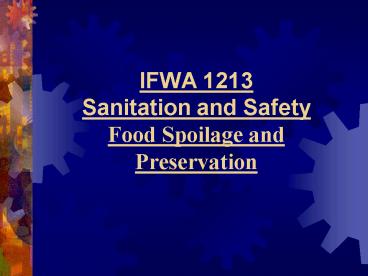IFWA 1213 Sanitation and Safety Food Spoilage and Preservation - PowerPoint PPT Presentation
1 / 28
Title:
IFWA 1213 Sanitation and Safety Food Spoilage and Preservation
Description:
2) Cook /Chill Cook conventionally then vacuum packed ... Chicken breast grilled or seared quickly (grill marks), pre cooled to low ... – PowerPoint PPT presentation
Number of Views:353
Avg rating:3.0/5.0
Title: IFWA 1213 Sanitation and Safety Food Spoilage and Preservation
1
IFWA 1213Sanitation and SafetyFood Spoilage and
Preservation
2
Autolysis
- chemical breakdown of food products by
substances within the food itself
(enzymes) Enzymes proteins that acts as
chemical catalysts
3
Common causes of food spoilage
- 1) Improper storage temperatures2) Incorrect
storage times3) Improper ventilation4) Failure
to separate foods5) Delays between receiving
and storage6) Poor sanitation standards
4
Food Classifications
- three types 1. Perishable foods
spoil fastest without processing or
preservation tend to be potentially
hazardous foods
5
Food Classifications
- 2. Semi-perishable foods longer
shelf/storage times when held at optimum
conditions 3. Non-perishable foods most
resistant contamination normally from
improper handling
6
Food Preservation
- four main objectives1) lengthen lag phase
of bacteria growth2) delay undesired
autolysis3) minimize pest / physical
damage4) prevent microbial action
7
Low Temperature Food Preservation
- Reasons for use1) slow growth /
reproduction of organism2) reduced chemical and
enzymatic activity3) easy to perform Problems
microorganisms are not destroyed
8
Chilled Storage (50 F to 59 F)
- reduced temperature used for storage
examples are potatoes
9
Refrigerated Storage (32 F to 45 F)
- slow rates of bacteria growth best
suited for perishable or potentially hazardous
foods Factors that affect storage
Relative humidity Ventilation / air flow
maintains humidity level controlled
atmosphere Modified Atmospheric packaging
(MAP)
10
Freezer Storage (O F and below)
- reduced Aw due to solidification Misconcep
tions about freezing spores can not survive
low temperatures damaged foods are ok to be
frozen blanching of fruits and vegetables
performed denatures enzyme activity and kills
some microbes nutritional value may be
lowered by freezing no air needs to be
removed when freezing rancid, freezer burn,
color changes
11
Quick-freezing
- reducing temp. to -4F in 30 minutes or
less smaller ice crystal formation
lower drip loss slowed microbial and
enzymatic activity
12
Quick-freezing methods
- 1) Blast freezer / chilled food cooled to
40 F rapid air movement low numbers
of ice crystals formed due to speed of chill
retention of texture and moisture due to the lack
of cell rupture 2) Immersion (nitrogen, brine,
sugar solution) - 3) Plate
13
Sous vide
- under vacuum Brief History Early
60s Healthcare opportunities in the US
and Sweden - 70s French influence hotel and
restaurant catering
14
Sous vide
- 80s French railways haute cuisine in
first class (quality concerns) Bruno
Goussalt determined parameters for
time/temperature and shelf life - 90s branding of product and expanded
use Hyatt uses for heart healthy products
15
Three classes or types
- 1) Hot Fill Vacuum packaged product while
still hot Chilled instantly Product
is 95 raw when packaged Used mainly for
liquid products (soups, sauces, stews)
16
2) Cook /Chill
- Cook conventionally then vacuum packed
Product is fully cooked, cooled, packaged,
pasteurized, chilled and stored Used for
inconsistent products (soups, stews, meatballs,
buffalo wings)
17
3) Sous Vide
- Product cooked and pasteurized in
package Raw materials used and preparation
is extremely important (product enhanced in bag)
18
Sous Vide Example
- Chicken breast grilled or seared quickly
(grill marks), pre cooled to low bacteria growth,
packaged under a vacuum environment, fully cooked
and pasteurized, prechilled to stop the cooking
and let the product rest and finally frozen
Shelf life of 18 months
19
Benefits from its use
- Retains / enhances tastes and odors
Reduced seasonings used Increased shelf
life Batch production increased
consistency Reduced food costs
Increased menu variety Reduced bacteria
growth (no TDZ)
20
Control points to note
- sanitation concerns Botulism
21
Thawing Techniques
- never at room temperature use
refrigerator temperatures perform under
running water consider part of cooking
process cook immediately if microwave thawed
22
Slacking
- increase temperature in preparation for
cooking
23
High Temperature Food Preservation
- two methods
- 1. Pasteurization product heated either to
145F for 30 minutes or 161F for 15 seconds
cooled immediately does not destroy all
microbes therefore refrigerate product
24
2. Sterilization
- high temperature stored in hermetically
sealed containers Three classifications
based on pH Low acid foods (pH above
4.5) Medium acid (pH 3.7 - 4.5) High
acid (pH
25
Aseptic canning
- separate sterilization of container and
product, packed in sterile environment
26
Dehydration
- lower water activity level four
types sun drying mechanical (spray,
tunnel, drum) freeze drying smoking
27
Chemical Preservation
- use of nitrates, sulfites, organic
acids can also use salts and sugar
reduces water activity
28
Irradiation
- exposure of food to gamma rays or UV
light regulated dosage

